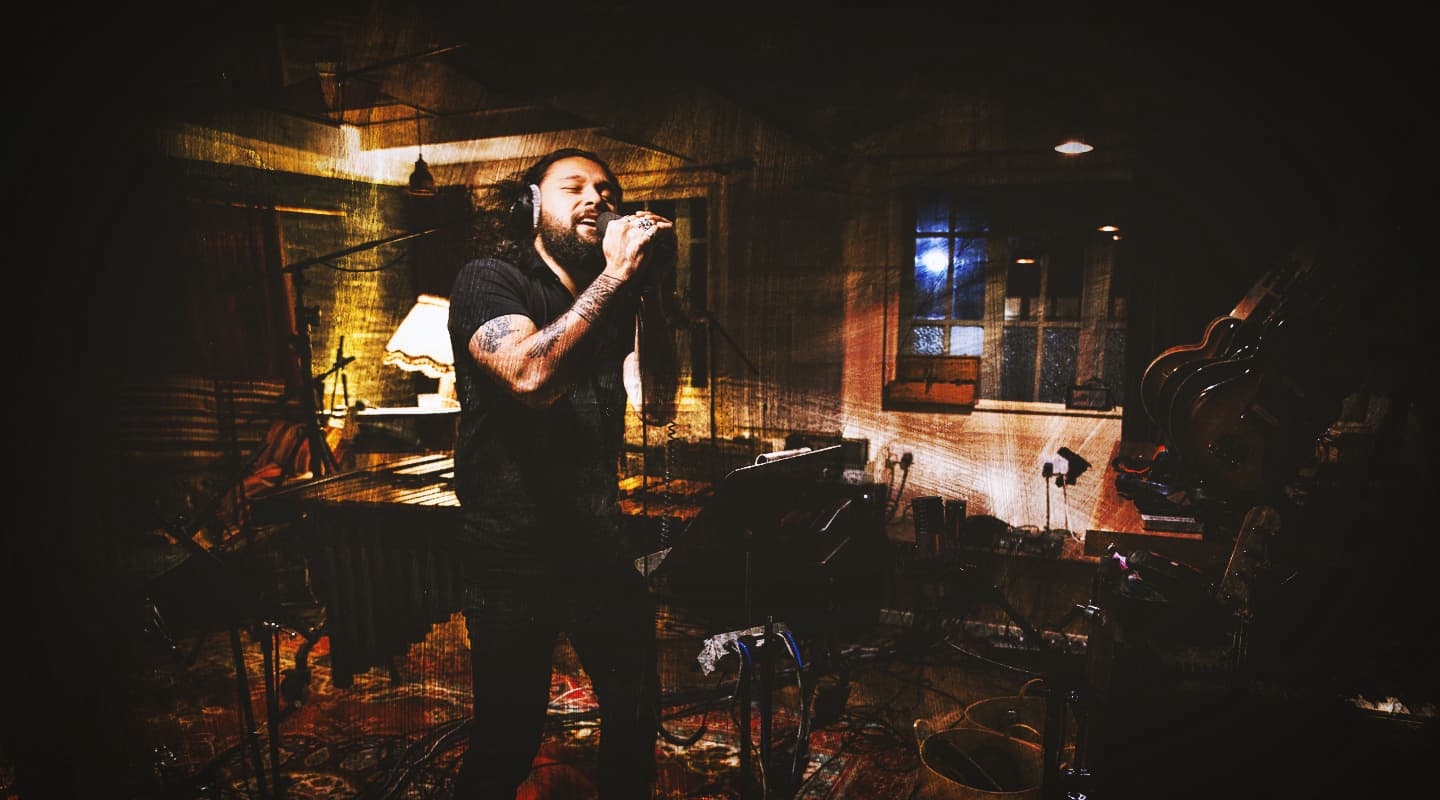
Gang Of Youths: Taking The Path Less Travelled
From recording Pacific percussion in a London warehouse to mixing dense and complex arrangements – this is the story behind Angel In Realtime.

Album: Angel in Realtime
Artist: Gang of Youths
With the release of 2017’s Go Farther In Lightness, Sydney outfit Gang Of Youths and their charismatic singer David Le’aupepe had a bona fide hit record on their hands. So what does an Aussie rock band do after having massive success with their previous album? Move to COVID-plagued London, set up a humble studio in a warehouse and self-produce an album based around Pacific Island field recordings of course. To lift the lid on the change of approach that inspired their new release Angel In Realtime, Greg Walker spoke to Gang Of Youths’ keyboardist/guitarist Jung Kim about how it all went down.
AudioTechnology: Angel In Realtime was mainly self-produced. It must have been a pretty different experience compared to making the previous record.
Jung Kim: Yeah, definitely. It’s been a completely different process and it took at least ten times longer than the previous one. I’d say about 90 percent of it was self-produced though at the start we spent more than a year working on it with other producers and engineers. We flew Peter Katis out to the UK for the first four months of production. Peter’s an old friend of ours who mixed a lot of the last album. This was the first time we asked him to come in as a producer. We also worked with Peter Hutchings, a great London-based engineer. For about the first four months, believe it or not, we were trying to make this record with no songs. We pretty much only had instrumentals to begin with. I’m sure you can kind of surmise how that panned out. It’s pretty hard to craft tracks in the studio without vocals, melodies or lyrics. So that’s basically what happened for most of the first year. A lot of the lyrics and melodies came in the last few months.
ISLAND INFLUENCE
AT: At that earlier stage were you already starting to work with the Pacific Island samples and loops or did that come later as well?
JK: We were working with the samples from the start but much more minimally. I think we were umming and aahing about what this whole record would be about, and Dave was playing with samples in his bedroom and not really giving it too much thought. We’d done quite a lot of rockier recordings in the past, and initially it was feeling quite reminiscent of all that. Based on the experiences and the stories that Dave was trying to tell regarding his Pacific Islander heritage and all these field recording samples that he was super interested in utilising in the music, it just didn’t seem like that was the right direction this time. So there was a transitional phase where we stopped working in big studios, moved into a warehouse and set up a pretty humble production place where we could meet up and experiment and try to figure out how to incorporate all these beautiful sounds. A while ago we discovered these incredible field recordings made by a gentleman named David Fanshawe. His family graciously offered us access to his archives. Through that relationship we were able to go on this journey of trying to tell the story of Dave’s heritage and also share this vast culture that’s been underrepresented, I think. Very little of it has been utilised in secular music so it’s been an interesting journey for sure.
AT: Was it a conscious decision to say ‘We’re going to produce this ourselves’ or did it just kind of evolve that way?
JK: There was definitely a pretty clear turning point where we decided we needed our own creative autonomy and the space to do and try out whatever we wanted. In professional studios it just comes with the territory that you have to be conscious of time management because time is literally money in that situation. When you’re working with engineers and producers in that environment there’s not so much flexibility, as opposed to spending an entire day literally trying to chop up a sample, which we did many, many times. We had to take our time with these samples to figure out how best to use them. Having more time meant we could also get more creative with drums and different miking techniques and different kinds of percussive elements, even working with instruments we had never recorded before. I think having our own space definitely gave us that creative freedom to do whatever we wanted without having someone trying to steer the ship from a logistical point of view.
AT: Were those field recording loops and samples sometimes the starting points of songs?
JK: Yeah, definitely. There’s a song called The Man Himself, and that song literally starts with the main sample that also plays throughout every chorus. The original demo started with that and a break beat. Eventually Tom Hobden wrote some string parts for it. That was one track that kind of wrote itself. It’s a really simple arrangement.
For about the first four months, believe it or not, we were trying to make this record with no songs. We pretty much only had instrumentals to begin with. A lot of the lyrics and melodies came in the last few months.

KEEPING TIME
AT: So it was pretty open-ended once you didn’t have to watch the clock?
JK: That’s probably why it took so long to create as well. It can become a bit of a wonderland where you just work in this constantly evolving circle trying to chase the dragon or whatever. It can turn into a pretty convoluted process, but I think it had to be this way in order for us to reach the place we did with this music. It’s definitely the most comfortable I’ve ever felt recording music. I’m sure most producers or bands or artists would relate and tell you if you’re not comfortable and you’re feeling quite self-conscious, or kind of anxious because of other outside pressures, it can be really hard to just be pure. And being really efficient sometimes means you’re not really getting to be at your absolute best. Not really knowing exactly what we were doing but just doing it anyway because we didn’t know any better definitely gave us a pretty humble attitude to recording and led to some pretty interesting results.
AT: It’s often difficult for bands to come off tour and go straight from that life back into the studio. Everyone’s expecting you to make a great record and you really haven’t had time to sort out your ideas or give them time to grow.
JK: Certainly, yeah, it’s a total paradigm shift and it’s one that we’re going through now the other way around. We just finished the record and now we have to tour the damn thing. All of us are multi-instrumentalists at heart. We all contributed in many different ways to this record. It’s not like one of us was glued to the drum kit or one of us played guitar the entire time. In the studio environment we all became producers. We all put on that hat, whereas on tour we have much more specific roles to fulfil. That was another exciting thing about being in our own space, everyone got to do whatever they liked. You’d rock up the next day and find someone had stayed behind all night working on the session and put down some banjo, and you didn’t even know this person played banjo! That’s just another thing that was really cool to explore and discover.
IN THE BOX
AT: So everything was tracked in that warehouse environment. Did you record straight into digital or did you have tape machines going?
JK: No tape machines, all digital. It was really nothing fancy, just a couple of preamps going into our UA Apollo. Those were our converters going straight into Logic, not even a Pro Tools rig or anything. It was just a really simple setup and we basically tracked everything like that.
AT: Speaking to your mixer Count (aka Mikael Eldridge), he said the sounds you guys recorded came up well and he was pleasantly surprised by the quality of the recordings.
JK: Did he say that? Oh man! I guess when you’re a fully functioning producer or mixer you must have sessions turning up from all over the world with all sorts of crazy shit on them. That’s a really cool compliment that he thought they turned out well. It’s definitely a cornucopia of everything, the samples, strings and other instruments like guitars and keyboards. In terms of keys, we used everything from Spitfire or Clang sample libraries to Eurorack modular synthesisers. Quite often we were referencing minimalist composers like Steve Reich, John Cale and Philip Glass. A lot of those percussive kinds of synthesised elements came from the modular synths. There’s also a lot of virtual instruments from companies like Arturia in there as well. We recorded very little real piano up until the very end. We were using this plug in by Native Instruments called Una Corda. Dave is really fond of a synth plugin called Repro-5 that’s made by u-he. It’s basically a software version of a Prophet 5. A lot of the basses and some of the pad textures are played on that. We’d also do things like taking a marimba or xylophone sound and add a little bit of tape saturation to bring it forward in the mix and stuff like that. It was a good combination of analogue and digital. There were no rules in terms of what we should and shouldn’t use. It was just whatever sounded good, basically.
AT: How has your role in the band it changed during over time?
JK: I was playing predominantly keyboards and piano, even though at heart I’m a guitar player. When the band started I just saw that role needed to be filled by someone. I naturally gravitated towards it too because at the time I was interested in synthesizers and keyboards anyway. I feel like if you’re into that kind of stuff, a lot of the time you’re into production as well. In a way the last 10 years has kind of led up to this moment. When the time came and we had to do this ourselves, every one of us had developed a lot of knowledge leading up to making this record.
THE BUDAPEST SESSION
AT: I wanted to ask you about the strings. Were you involved in in writing the string parts and recording them as well?
JK: All of the string arrangements were composed by Tom Hobden. He basically wrote 13 songs’ worth of 60-piece orchestral compositions in two or three weeks. Him and Dave went to Budapest to record with the Budapest Symphony Orchestra and recorded all of them in one day. I have to take my hat off to Tom. It was amazing. He’s a machine.
AT: So did you didn’t get to go to Budapest for that session?
JK: Tom and Dave went over and had a little mini holiday in Budapest while we were cleaning up all the sessions in London. Making all the edits clean, you know.
AT: Was there a time later on where you were waiting for Dave to come through with the lyrics and melodies?
JK: There definitely was a period where we just needed to wait. We had to be very patient. Given the nature of what the album ended up being about lyrically there was quite a lot of soul searching that needed to happen. A lot of the things Dave sings about on this record were very fresh. Him suddenly finding out that he has this huge cultural heritage that he didn’t really know he had was big. A lot of this information was, in a way, not necessarily hidden, but sort of kept away up until the death of his father. Obviously, the death of someone’s father, there’s a process to that as well. There’s a large support network within the process of making a record and, for our part, we wanted to make sure we gave him support and there was that sensitivity and patience to let him take his time with it. It’s very deep subject matter to talk about and it needs to be investigated thoroughly, I think from an introspective point of view in order for it to come out in public.


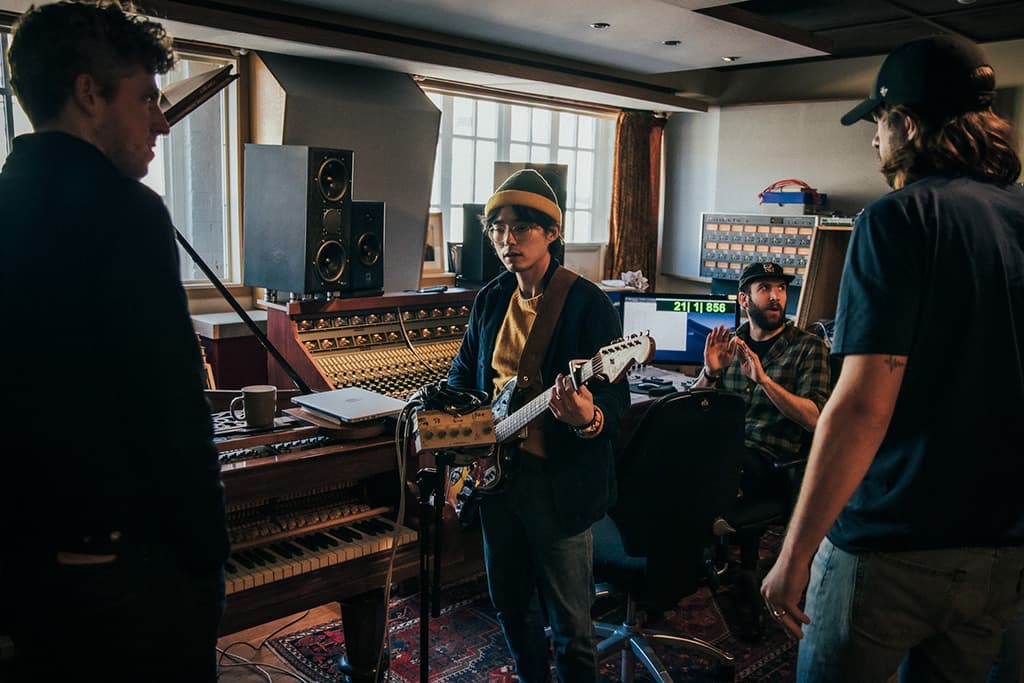
MAKING IT COUNT
Count (aka Mikael Eldridge) is a producer, mixer and mastering engineer based out of San Francisco. His credits span a wide variety of genres and include big names such as Radiohead, the Rolling Stones, DJ Shadow and Frank Sinatra to name just a few. He talked to AT about working with Gang Of Youths on their new album and how using some cutting-edge tools and techniques helped fit everything into some pretty dense mixes.
AudioTechnology: How would you describe your role working on this album?
The Count: I mixed and mastered, and my role evolved to include general counsellor and therapist as well. I provided a fair bit of emotional support, as often happens when I work on albums like this that are ambitious and challenging to put together. In other words, it’s not just a three-piece punk rock band or a straight up dance act. DJ Shadow and Tycho are good examples of other artists I work with that have a similar level of difficulty. You know, finishing the record is quite difficult. It takes a lot out of you. It’s not like those recording sessions where you get three or four great jazz musicians in a room and four hours later they’re done and they don’t think about it ever again. There’s quite a lot going on on this record. Arguably, too much.
AT: It’s a modern dilemma that people find it pretty hard to step away and say it’s done.
TC: That’s probably one of the roles that I find myself taking on with these kinds of records. I might get hired to mix and it sort of evolves. I end up becoming co-producer, adding parts or moving parts. One of the biggest questions people rarely ask is ‘when is it done?’ It’s usually me having to tell them ‘OK guys, we’re not adding any more, we’re removing stuff from this point. There’s too many cool ideas competing with each other.’
AT: With any band’s move into self production there’s scope to create a pretty complex result.
TC: Yeah. They actually did a great job of it, too. I work with a lot of different artists that have varying degrees of savviness with computers and audio engineering. The sounds Gang Of Youths delivered were actually quite good. I was surprised. There’s definitely a few recordings where they captured a really great moment with Dave and the piano and I’m like, ‘I wish the piano wasn’t noisy and I could separate the vocals’, those kinds of little things. But for the most part I was quite impressed with things like the drums where most bands are not super capable of getting high quality results. I was pretty happy with what I was getting.
PULLING STRINGS
AT: How did you approach the strings?
TC: Early on I thought it might be a struggle. Fitting in smaller parts like violin or viola was OK. I was listening through the songs and then they told me what they were planning on doing. I thought ‘Oh my God, they want to add more strings to this!’, and not just a couple of regular overdubs but literally an entire orchestra. When they told me that I was like, ‘I hate to be the one to say it but, guys, I think if you do that you’re going to shoot yourself in the foot. There are so many interesting sounds on these songs and those sounds are specific. This is going to cover up all these very particular sounds that you’ve used and that are integral to the concept of the record.’ Especially the Pacific island samples, the choirs and percussion. That stuff is so important to the story of every song on this record so the danger was in covering that up and not getting the full feeling of it. So I thought, ‘Oh God, no strings’. But then they go to Budapest and they come back with the most unbelievably perfectly recorded strings I’ve ever worked with. I was actually able to fit them in without destroying the whole mix or compromising to such a degree that I had to completely get rid of things. So it was kind of the ultimate challenge as a deconstructive mixing process. This record probably ranks either number one or two. Tycho’s records for sure used to be my number one ranked most difficult but rewarding albums, but this one might have just overtaken it for top place.
AT: I can hear that those strings are playing some of the same roles that other sounds play, but you’ve managed to make space for them.
TC: Yeah, they were incredibly recorded and I didn’t have to struggle like I normally do to carve out space for them. I was pleasantly surprised by that, but it did require a level of attention to detail that most people either are not willing to go to or maybe not able to sustain. It was very difficult and took a long time. After getting through that process and being able to listen to it for what it is, I’m really happy that extra effort. I think it really paid off. Certain things had to be done section by section in each song. There are songs that have three completely different drum kits so each section of the song has 40 different mics for drums and seventy two tracks of orchestra and those sections had to be mixed completely differently. There are parts of a song where you really want to hear the Polynesian percussion coming through, and then the very next part of the song you don’t want to mute them or get rid of them or turn them down, but you need to create more space for something else. I had to do outrageous things that nobody really would have thought to do even just a few years ago. So OK, the percussion really needs to poke through and you really need to hear it here for just five seconds, then I need to keep it at the same level but actually remove all the transients. Things like that. I was automating transients. Rather than adjusting levels I’d do that so I could allow the strings to be heard while still allowing the percussion to be felt, but not the attack of it.


PACIFIC PERCUSSION
AT: What was it like working with the Polynesian material?
TC: That stuff was great in a lot of ways. It really adds to the emotion… I’m sorry, right as I say the word ‘emotion’, I’m literally choking up on a smoothie that I was drinking. Sorry.
AT: That’s not emotion?
TC: That’s not emotion. OK. Blueberry.
Those field recordings were so key to adding an emotive quality to certain sections of the songs, and I was so glad we had them. They just felt so authentic and powerful. The challenge with the samples was to get them to sound more dimensional. A lot of those samples are old archival material and so the full frequency range isn’t quite there, but they sound so damn cool. With the way the band layered their own percussion on top, we were able to layer these things to make them enormous and really feel like you’re in the room with them. You know when you hear a record that has ocean waves on it, the sound is often very two dimensional, very flat and it doesn’t sound anything like when you’re actually at the ocean and the waves are crashing all around you. That’s what I was trying to get away from with those samples. It helped that they were blended in with the band’s percussion. We had to fudge a little bit to get those things to work, and sometimes I wanted them to really feel stereo. I sometimes used the the Brauer Auto Pan that Waves came out with a few years ago. No one I know uses it and I don’t understand why because it’s so great. I used it to get more of a cycle panning feel, you know where it’s sort of going around your head as opposed to just left and right. I wanted to get it to feel the same way the waves do when they’re crashing. I didn’t want that super disappointing two dimensional sound. I also had to try a few other ways of achieving that because it didn’t work the same on each song.
AT: What were the challenges of incorporating those sounds and all the other ambient elements with the more standard rock instrumentation?
TC: Luckily the guitars were tastefully done and just put in certain places. Unlike a lot of their stuff in the past where featuring the giant-ness of the guitars would have been key, there was a lot of space that was left so I didn’t have that challenge of fighting against the guitars. It was more about how to make the drums huge. The drums plus the percussion together needed to feel like one giant thing, and that also needed to have its own space. It was more of a drum challenge than a guitar challenge in terms of the traditional rock elements.
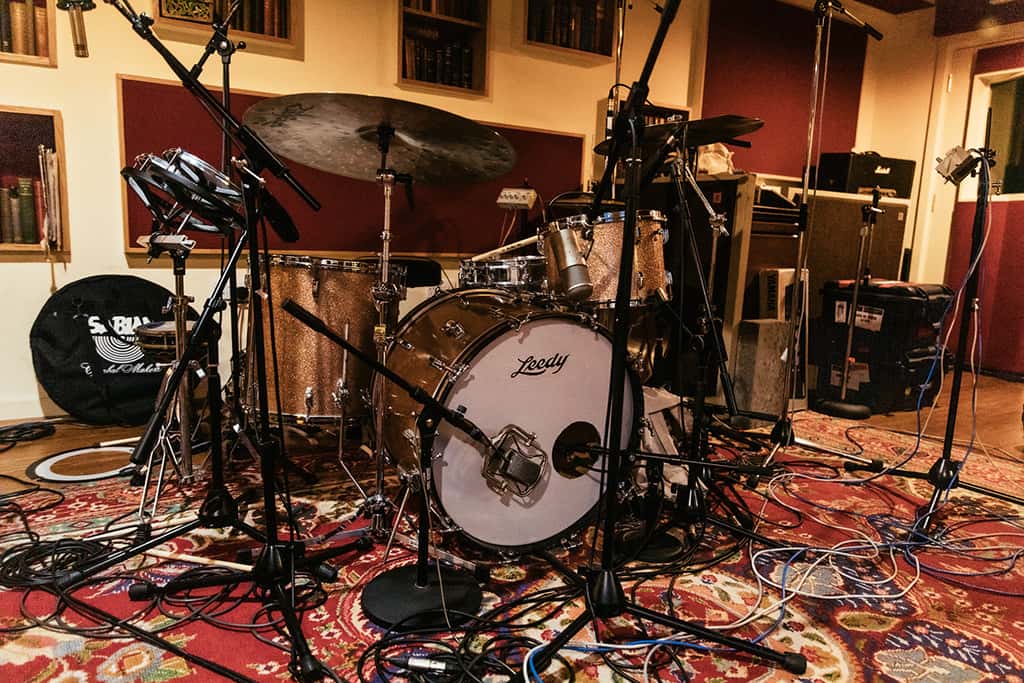
Then there were synth basses that had to work with electric bass. Those also required a lot of detail. Which moments do I feature the bass? Which is going to have the fullness of the low end and which is going to be gritty? I’ll distort it here in this part of the song. And then on the verse of the song, I will un-distort it and I’ll make it round and fat, but then I’ll have to get rid of the synth bass. So it was a kind of a Tetris jigsaw puzzle. I spent more time than I have on any other record going through the tracks they sent me before even starting mixing to try to reorganise it. That’s where Pro Tools’ new track folders saved me from ripping out all of my remaining hair because I could organise these things by section and by parts. Actually I got the opportunity to give Avid a lot of feedback when they were developing that feature and it really helped to arrange things. I needed to figure out what needed to dip down and go away in terms of volume, what needed to change in terms of frequency and what needed to change in terms of placement. Every section of every song had a lot of that. I listened to it for the first time in a while after giving myself a break from hearing it. Thankfully I don’t feel that stuff happening. It sounds quite fluid going from start to finish of a song, but you know, things are getting constantly re-panned and re-EQ’d from section to section.
VOCAL TREATMENT
AT: Dave’s voice feels quite natural compared to a lot of the other sounds. Was there much treatment on the vocals?
TC: It was different for every song. Unlike a lot of records I work on that might have a softer, breathy delivery that is quite challenging in a dense mix, Dave’s voice naturally breaks through. I’ve worked with artists that have beautiful, breathy voices. We build these intricate, dense tracks and then it’s a real challenge to get vocals to cut through. Because there’s lots of layers of interesting things that are somewhat ambient on this album, I decided not to go heavy at all on vocal effects. Normally I work with a lot of music that lends itself to that, and I certainly don’t have a problem with it. Even on an album like this, if it weren’t quite so layered, I would have been happy to play around with tons of effects on Dave’s vocals. Here I found the effects covered up these little elements that were so cool and I just didn’t want to do that. Another factor was that even though the album is generally quite layered, his vocal isn’t. In fact there’s very few places where there are any harmonies or even vocal doubles. It’s literally just one strong lead vocal and it worked really well to cut through and be the focal point amongst all of the layers. There’s one quite psychedelic kind of song called Tend The Garden where I decided to go for more effects. I had quite a few layers of these flashy psychedelic phasers going. Three of them at once just to give it a little bit of a tweak. But generally even though there are often four different vocal effects on a lot of these songs, they’re all very subtle.
On this album, even from the very first song, I was searching for a long time trying to figure out how I could saturate Dave’s voice so that it didn’t feel too heavy-handed and didn’t fatigue your ears. I ended up using the Waves SSL Channel Strip to get this very nice clean saturation. That was actually really important to me on this record. When I wanted something just a little bit more aggressive I’d use the new PSP saturator plug in. The other thing was Oeksound’s Soothe plug in. I’ve been using their stuff from the very beginning and Soothe was really helpful because Dave is such a dynamic singer. I was doing everything I could to not just rely on heavy-handed vocal compression. Obviously, I destroyed drums like crazy on this album and there’s tons of that lovely, heavy-handed, distorted compression there, but I didn’t want to do too much of it on the vocals. Dave’s vocal treatment was a decidedly different approach for me.
AT: Are you basically in the box or are you running through a console?
TC: I’m in the box using a Universal Audio Apollo and Genelec monitors. I just decided to streamline the hell out of everything. I’ve always been a plug-in freak so I will get anything that looks remotely interesting. For the past few years, I’ve just been chugging along with my ‘cheese grater’ Mac Pro and it was killing me. I’d been hearing rumours about the new iMac Pro and I was finally able to upgrade when it came out. It gave me the headroom I needed and the resolution of the screen is so nice to work with. It was just one of those life changing things, like for some people moving into a new house where they finally have space. That’s what it kind of felt like to me. So now it’s all plug-in based.
I still spend more time than I think I should on a mix. For example, if I mix a song and I get a nice drum sound or vocal sound, I do not ever, ever import those settings from song to song. I literally go through and try twenty five different compressors on the next song to see which one I like better. I know it’s probably a waste of time but, I don’t know, I’m a freak about it. It gets exponential too, because I’ll spend a lot of time and find something. And then I think, ‘well, what if I layer them? What if I layer all three compressor sounds on these drums?’ I did a lot of that stuff on these mixes too.
AT: Any last thoughts about working with Gang Of Youths and making this record?
TC: There are so many things to say about it, because it really is a concept record. What I love is that the band at some point embraced that idea and said ‘I just don’t give a shit if critics like this record, I don’t care if people think it’s too ambitious or too whatever. We want to grow and do something different’, and they just f*cking went for it. I love that. I really appreciate that, and the fact I got to be the one at the helm to help them piece it together.



















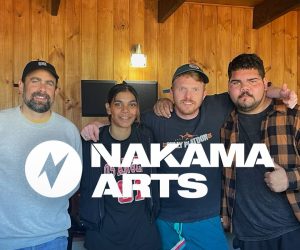




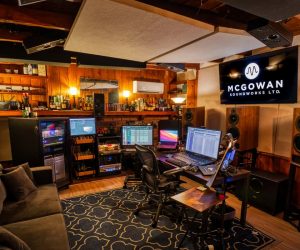



RESPONSES